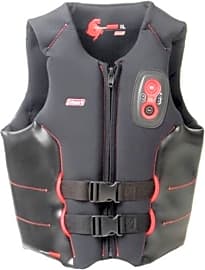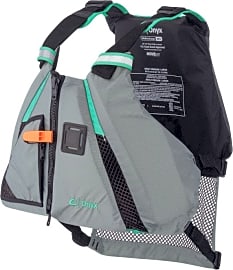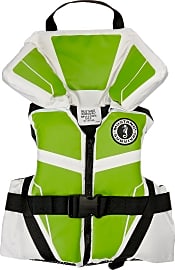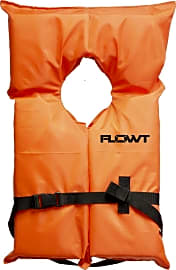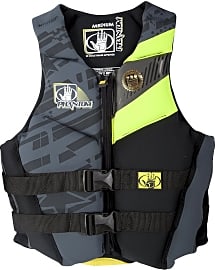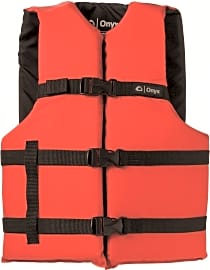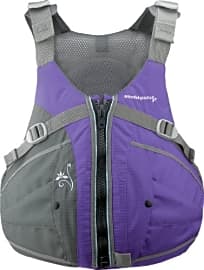The 10 Best Boating Life Vests

This wiki has been updated 35 times since it was first published in June of 2016. Whenever and wherever you decide to go boating, remember that a life jacket is a safety essential. But which specific model you choose depends a lot on how you're spending your time out on the water. This list brings together a wide variety of styles, from fitted vests ideal for extreme sports like tubing and wakeboarding to options with lots of pockets designed for fishing. When users buy our independently chosen editorial choices, we may earn commissions to help fund the Wiki.
Editor's Notes
February 28, 2020:
In a relatively slow-moving category, we only saw fit to remove the Imax Auto-Vox Inflatable, which was a relatively cheap option that couldn't sustain floatation long enough to make the cut. After all, if you're in the water for an extended period awaiting help, the last thing you want is a vest that might slowly deflate or take on water.
In its place, we added the Coleman Transmit, which is a polar opposite to the Auto-Vox in many ways. It's durable and reliable, and it even has a built-in radio with 14 channels and plenty of range. It's an expensive choice compared to its competition, but when you compare it to the cost of a life vest and a handheld marine two-way radio, it's actually a pretty good deal.
The Jaws Of Life
For him, drowning would be preferable to bobbing up and down in the water, not knowing if help would ever come, and watching as the men around him were eaten alive.
At the end of one of the most iconic movie monologues in film history, Robert Shaw, in the role of Captain Quint in 1975's Jaws, declared, “I’ll never put on a life jacket again.” For him, the decision is somewhat justified; he just spent the past few minutes telling us about the hours he spent waiting for sharks to devour him after his boat, the USS Indianapolis, sank toward the end of WWII. For him, drowning would be preferable to bobbing up and down in the water, not knowing if help would ever come, and watching as the men around him were eaten alive.
For the rest of us, drowning is the least desirable result of a mishap on the water. So, to keep us from drowning, we don life vests every time we leave the slip. In many bodies of water, it’s illegal not to go out on a boat without a life vest on, but given how reliably they can prevent drowning in almost any situation, it seems ridiculous that anyone would choose not to wear one.
Life vests are so effective thanks to their inherent buoyancy. The natural upthrust of a body of water is far greater than the gravitational force of the vest, even when it’s attached to a large human body, and so it can easily keep that body afloat. Even if you were to bang your head on the rail of the boat before toppling over the side, rendering you unconscious and unable to support yourself in the water, your life vest would keep you safe. That’s because they’re designed with greater buoyancy in the front than the back, so they can naturally help your body turn over to a position that won’t leave your face submerged in the drink.
Of course, if there’s a supernaturally large, wantonly vindictive shark hunting your ship, it might not matter what you wear. After all, it wasn’t the water that did Quint in, it was the massive jaws of a man-eating great white.
Which Life Vest Is Right For You?
If you’re going out on a boat, you need to wear a life vest. But which one will you choose? Beyond obvious considerations like available sizes, are there really any important differences among the options on our list? The answer is absolutely, and it all depends on the boat you’re in and the water you’re on.
For example, if you’re on a small lake with a lot of people around, and you want to go out in a little canoe, you might not need the most advanced, expensive option on our list. Something simple will serve you just fine, as you can bank on getting help in the event that you capsize.
In these situations, you’ll want something reliable, with a high degree of adjustability to ensure a snug, safe fit.
Boating on larger bodies of water or in places that aren’t as well populated is another story altogether. In these situations, you’ll want something reliable, with a high degree of adjustability to ensure a snug, safe fit.
As for the kind of boating you’re doing, your activity level can help determine your life vest choice. Sitting in the back of a fishing boat while casting a lazy line might not necessitate the most comfortable vest on the market, but a whitewater kayaking expedition will require a durable, adjustable model that also has plenty of room in the arm holes for significant paddling movement.
You might also prefer an inflatable life vest, as these are much easier to pack up for storage. If you plan to do some traveling where you know you’ll be on the water, but you don’t know whether you’ll be provided with a life vest, these make great investments.
Keep an eye out for extra features, as well. Some vests come with pockets that can contain everything from emergency water pouches to extra fishing tools. These are ideal if you want to replace your fishing vest with a life vest, or if you’re going out on open water. Some vests also include flashing lights or whistles to make it easier for rescue workers or other sailors to find you.
If all these considerations are met, and you still have more than one vest to choose from, then you can go ahead and consider style. Some options come in a few different colors or have flashy logos or designs. It’s far from the most important thing to think about, but if you’ve got a kid or a teen who thinks they’re too cool to wear a life vest, having something that looks as awesome as they think they are might help ensure that they wear it.
A Brief History Of The Life Vest
Drowning is terrifying, and there’s nothing about our modern society that makes it more frightening than it must have seemed since the first human being experienced it. As such, we’ve been looking for ways to prevent that particular fate for as long as we’ve interacted with bodies of water. Ancient civilizations used everything from inflated animal bladders to sealed gourds as flotation devices, but these were all handheld options that made it more difficult to swim, and wouldn’t be of much help if you ended up in the water without holding onto one.
There are inflatable varieties available, as well, but these are generally better for emergency situations in places where storage space is paramount, as on an aircraft.
In the very early 1800s, vests made out of cork were worn by sailors intent on surviving at sea, but no such vest or device was included in the basic equipment kits issued to naval sailors for some years. Cork vests dominated the landscape until kapok, a lightweight vegetable material, supplanted it in the early 20th century. These vests proved much more comfortable and flexible, allowing wearers to perform more of the necessary tasks associated with sailing without having to temporarily take their vest off.
Most of today’s life vests are constructed from nylon or similar synthetic materials, and they have pockets filled with buoyant foam that is very inexpensive to produce and that requires next to no maintenance on the part of the user. There are inflatable varieties available, as well, but these are generally better for emergency situations in places where storage space is paramount, as on an aircraft.




